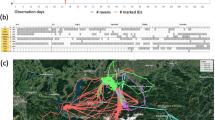Abstract.
The possible effects of foraging strategy on the relationship between vigilance and group size were studied in three species of waders with different foraging strategies. I predict that (1) pause–travel species should show no relationship between scanning and group size, because these species scan for prey as well as for predators; (2) continuous-tactile foraging species should show a positive relationship between flock size and vigilance level, because in their large groups vigilance towards other birds could be used to avoid interference and aggression; and (3) continuous-visual searching species should show the general pattern of decreasing vigilance when group size increases as predicted by both the 'many eyes' and the 'predatory risk' hypotheses. Results support the predictions for the influence of foraging strategy on the relationship between vigilance level and group size. The mutual exclusion of foraging and scanning can determine the importance of the 'many eyes' hypothesis. Such exclusion seems to be determined by foraging strategy. The influence of foraging on scanning must be taken into account in future studies on the group-size effect.
Similar content being viewed by others
Author information
Authors and Affiliations
Additional information
Electronic Publication
Rights and permissions
About this article
Cite this article
Barbosa, A. Does vigilance always covary negatively with group size? Effects of foraging strategy. acta ethol 5, 51–55 (2002). https://doi.org/10.1007/s10211-002-0059-0
Received:
Revised:
Accepted:
Issue Date:
DOI: https://doi.org/10.1007/s10211-002-0059-0




